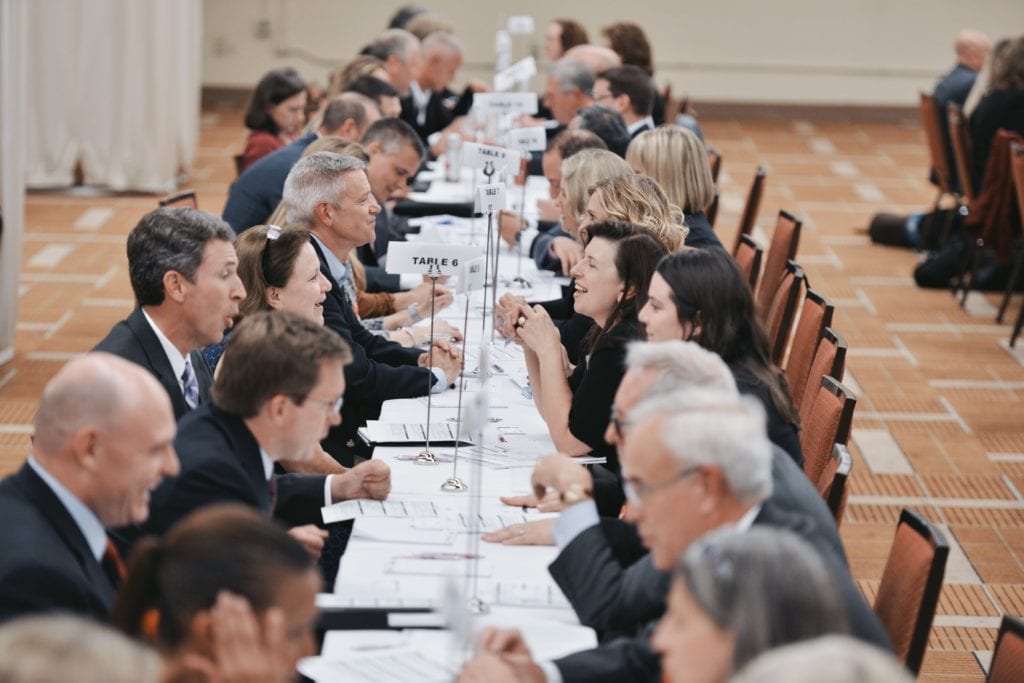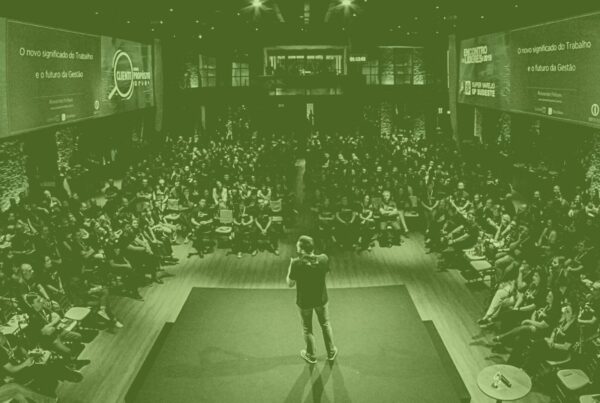Conference planning is well underway. You’ve secured a convention center in a city that’s going to get people excited. You’ve booked a keynote speaker that is sure to wow! You’re focused on providing engaging and interactive sessions for your attendees. You know that conference networking is important, but you’re not sure how to help your attendees make meaningful connections.
Don’t worry. You’re not alone. And it’s good you’re giving this thought and doing your research. A recent study done by the International Association of Exhibitions and Events (IAEE) showed that 76% of almost 9,000 participants said networking was a top driver when deciding whether or not to attend a conference or event.
That’s pretty powerful. And it should make you think long and hard about the ways you’re connecting your attendees.
A lot of event planners think simply bringing people together in the same place is enough to help attendees network—think coffee breaks and cocktail mixers. While there is certainly nothing wrong with offering these types of networking events (many people enjoy the opportunity to meet in a laid-back setting), they don’t guarantee your attendees will make meaningful connections. It’s essentially a free-for-all. And it’s all up to luck whether or not your attendees will come in contact with the right people in the room.
In order to help your attendees really form concrete connections with relevant industry professionals, there needs to be an element of strategy and structure when it comes to conference networking.
Here’s how to help your attendees make more meaningful connections.
Use technology to enhance your networking events.
 Technology-enhanced networking can offer your attendees networking opportunities that go above and beyond traditional mix and mingle events. Between matching software, event apps that allow for online and in-person networking, and technology that has LinkedIn integrations, advancements in technology are helping event planners provide more strategic networking to their event-goers.
Technology-enhanced networking can offer your attendees networking opportunities that go above and beyond traditional mix and mingle events. Between matching software, event apps that allow for online and in-person networking, and technology that has LinkedIn integrations, advancements in technology are helping event planners provide more strategic networking to their event-goers.
Here’s how each of these technologies—matching software, event apps, and networking apps—can help your attendees form more concrete connections.
Matching software:
Matching software uses customizable matching parameters and an advanced algorithm to create highly targeted networking events, where attendees are paired together based on mutual interests.
More often than not, when it comes to conference networking, it’s easy for attendees to feel overwhelmed and frustrated with the lack of quality connections they come into contact with, especially in a room full of people they know nothing about.
With matching software, event planners are able to create customizable matching categories to connect their attendees in a way that fits their unique event needs. These categories can include things like job title, experience in the field, geographical region, interests, career goals, objectives, and anything else that is specific to your industry or event.
Event Apps:
Event apps are another popular tool event planners are using to connect their attendees. With a wide range of apps out there, event planners have quite a few to choose from.
Most event apps offer in-app messaging, so attendees can network online or schedule something in-person. Others allow for LinkedIn integration so attendees are able to stay in contact with their new connections after the event is over.
While event apps don’t always create as many face-to-face networking opportunities, it’s a convenient way for more digital-savvy people to connect with fellow event-goers.
Many event apps offer more than just a networking platform. Event apps help event planners communicate with event attendees about session updates, speaker information, and schedule changes. For this reason, some event planners prefer to use event apps to eliminate the need for multiple technology or software companies.
Let your attendees preselect the types of people they’re interested in meeting.
One of the biggest complaints people have about networking events is not meeting the right people. And handing out business cards in a crowded convention center isn’t likely to lead to any meaningful connections or build business relationships.
But when you let your attendees preselect the types of people they’re interested in meeting, you eliminate the uncertainty or guessing game attendees usually face when networking in a room full of people they know nothing about.
Here are some ways you can empower your participants and increase the chances they network with the types of people they want to network with. And why it’s important to do so when it comes to conference networking.
Connect people who have shared interests:
Letting your attendees network with like-minded individuals goes a long way in ensuring networking opportunities are worthwhile. After all, it doesn’t do much good to try to connect with people who have nothing in common.
Instead, focus on connecting people with similar interests. By doing so, there’s a much higher likelihood that they will be able to share more relevant information and set the foundation for a long-term relationship, rather than a short-term transaction.
Connect people who have similar jobs within an industry:
Networking is all about providing value to other people. And that’s a lot easier for your attendees to do when they are connecting with people whose experience aligns with theirs. This way, they are able to better share knowledge, bounce ideas, discuss trends, overcome challenges, and talk about the industry and/or job outlook.
From an attendee perspective, it’s also nice to know people who have similar skills as you but might be applying them in different ways based on the organization or corporation they work for. Plus, when it comes time to job search, having a network of people outside of your everyday coworkers or colleagues is paramount.
Connect people who work in the same geographical region:
Even though we live in a much more connected world than ever before, connecting people from the same area greatly increases the chances that the relationship will be long-lasting. And no matter what an attendee’s reason is for networking (increasing sales, finding a new job, expanding their circle), it’s always better to have a network in the same area.
Or, for those looking to make a move, let them specify what area they’re interested in so they can start expanding their circle there.
If you can’t tell, when it comes to improving networking opportunities for your attendees, its all about empowering your participants. Not sure how to collect this data and appropriately match people? We’ll give you a hint: matching software.
Offer more structured and strategic networking sessions.
By now you know: mix and mingle events are great, but they aren’t always the best way to connect your audience. Most times, events like cocktail mixers or coffee breaks do very little to encourage event-goers to branch out from those they already know.
Unstructured networking events also require your attendees be more outgoing and approach random strangers (which isn’t always easy for some people). With structured networking events, attendees don’t have to.
Here are some ways to offer more structured and strategic networking sessions.
Speed networking:
Speed networking is becoming an increasingly popular form of networking all around the world – and it’s no surprise why.
This accelerated one-on-one conference networking format solves the most common challenges people face while networking. Think: getting stuck talking to the wrong person, not meeting the right people, and not meeting enough new people. Because let’s face it, we’ve all experienced these things a time or two at mix-and-mingle events.
In addition to being an accelerated (and especially effective) way to meet more people, speed networking technology can be used to help your attendees connect with like-minded individuals. Through matchmaking software, event coordinators can have peace of mind knowing that their event-goers will meet with people who have similar interests.
Not only that, but the structured format of speed networking also helps attendees feel less nervous and anxious about networking. Because instead of having to gather up the courage to approach complete strangers in a crowded convention center, everything is facilitated for them.
So, we’ve gone over the ways that speed networking helps to prevent attendees from getting stuck talking to that person that goes on and on and on about something you just aren’t interested in, as well as how it helps connect like-minded individuals, but how does it ensure attendees are meeting enough new people? The answer is simple. On average, a traditional 90-minute networking event with 100 participants will generate about 300 new connections but a speed networking event will produce 1,000+ new connections in the same time period. That’s 333% more meetings!
Roundtables:
Roundtables are a not-so-new form of networking, but another event format that is greatly improved with the help of technology. With targeted roundtables, strategic seat assignments can be created with the touch of a button so that event planners can strategically bring groups of people together without having to spend a ton of time in excel trying to manually match people.
Targeted round tables are great for things like luncheons, dinners, or team building activities.
Targeted connections:
If you don’t have the time or resources to plan a dedicated networking session but still want to help your attendees meet relevant professionals, targeted connections could be a good option for you. New to the networking world, targeted connections provide customized lists of people for your attendees to reach out to. How? You guessed it. With matching software!
The nice thing about targeted connections is that event planners don’t have to take into account the schedules or agendas of all of their attendees. And that’s often one of the hardest parts of scheduling. With targeted connections, attendees can network whenever it works best for them and however, it works best for them.
They can meet for coffee, grab drinks, or get a meal together. The opportunities are endless!
Smart badges:
Smart badges are the new kid on the block when it comes to how we can connect our attendees. They are a form of wearable technology that lights up when two people with similar interests come in close proximity. With a visual representation of the people you should approach, event attendees often feel less anxious approaching strangers.
Not only is it expected, it’s guaranteed the two people will have something in common.
They also reduce the time it takes for attendees to make meaningful connections. Instead of aimlessly wandering around having unproductive conversations, attendees can see exactly who shares their interests. In a way, smart badges are ready-to-wear networking tools, making it a true grab-and-go option.
To improve conference networking, be intentional with your networking event objective.
Effective conference networking is more than just fancy technology and tools. Defining a networking event objective is just as important.
Help attendees connect with fellow peers:
Peer-to-peer events are probably the most common way to connect attendees. These types of events connect industry professionals who are at similar points in their careers. This is a great place to start if you’re not what type of conference networking to offer.
Help attendees find mentors/mentees within their industry:
Mentor-mentee events help pair experienced professionals with attendees who are hoping to gain knowledge and experience. No matter how far you are in your career, finding a mentor is extremely important in your career growth. And mentoring someone is one of the most rewarding relationships you’ll have as a business professional.
So, when thinking about conference networking, mentoring events are extremely valuable. They benefit both the conference attendees and the companies they come from. Some key benefits of corporate mentors include increased productivity, leadership development, and job satisfaction.
And why do those things matter? Increased productivity in company employees contributes to increased profitability. And when you offer your employees opportunities to be a mentor, you empower them to become natural leaders. This, in turn, also contributes to increased company loyalty and decreased turnover. It’s a win-win-win-win-win.
When you give your employees the opportunities to lead, they are encouraged to make a difference in the organization. Oftentimes, in ways that are different and outside of their day-to-day responsibilities.
In addition, people who take part in mentoring programs have a much better understanding of their positions. They’ll feel more excited about reaching their goals. And are more likely to work better with their coworkers and contribute more to the overall betterment of the organization.
Help connect buyers with relevant sellers:
In the world of expos, trade shows, and conventions, it’s challenging to find ways to effectively connect buyers with sellers. Or, more specifically, it’s challenging to effectively connect the RIGHT buyers with interested sellers.
All in all, it’s safe to say strategy and structure are key to improving conference networking. And helping your attendees form concrete connections. With today’s technologies, it’s no wonder attendees expect more than just mix and mingle events or quick coffee breaks.
So while those types of programming are certainly nice to include, conference networking should go further. It should include efforts to intentionally bring the right people together. And in a way that maximizes their ability to build meaningful relationships and expand their circle.
After all, networking opportunities are a top deciding factor for 76% of potential conference-goers. Here’s to planning, preparing, and connecting your attendees in ways like never before.

















